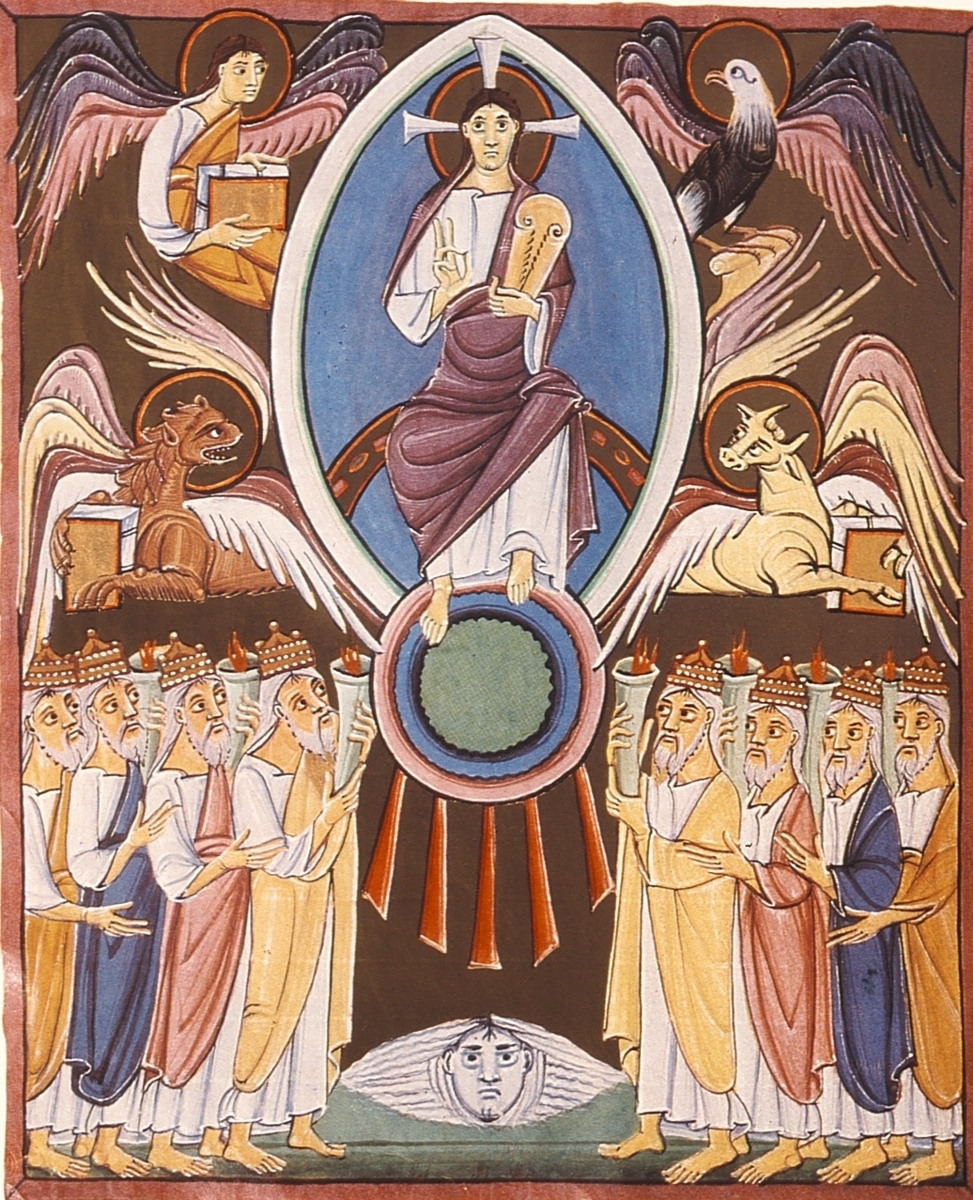One of the most beautiful things about Catholic worship, particularly when it’s done well, is that it’s a full-body experience. We smell the incense, we sing Psalms and hymns (and hear these being sung), we listen to the Scriptures and the homily, we see the Sacrifice of the Mass (and the priest’s liturgical gestures are loaded with meaning), we kneel, sit, stand, we taste the Blessed Sacrament, we embrace at the sign of peace. The Liturgy reflects the Catholic view of the body, and of matter, and our deep-seated belief that Creation should give glory to God. It’s also consistent with the worship of the Old Testament, of the early Christians, and of the apparent Heavenly Liturgy described in the Book of Revelation.
 |
| Limbourg brothers, The Ark of God Carried into the Temple (1416) |
Worship in the Old Testament engaged each of the five senses: hearing, sight, touch, smell, and taste. Hearing was engaged, along with the gift of speech, in the proclamation of the word, in the singing of hymns, and in vocal prayer. The Shema Yisrael, perhaps the most famous Jewish prayer, begins, “Hear, O Israel…” (Deuteronomy 6:4).
Old Testament worship was no less tied to the sense of sight. The Mosaic Law contains incredibly precise instructions for the materials to use in worship, and both Temples were built according to plans intricately detailed by God (see, e.g., 1 Chronicles 28). In worship, religious images and statues were used, such as the golden cherubim in front of the Ark of the Covenant (Exodus 25:18), and the depictions of the cherubim on the Temple Veil (Ex. 26:31). Full chapters deal with specific details like what priestly vestments should look like, and the materials to be used in designing them (see, e.g., Ex. 28).
Smell was engaged, in the use of incense. In fact, the Mosaic Law prescribed special incense to be used that was only permitted to be used in worship, creating a holy scent tied to worship (Exodus 30:34-38):
And the LORD said to Moses, “Take sweet spices, stacte, and onycha, and galbanum, sweet spices with pure frankincense (of each shall there be an equal part), and make an incense blended as by the perfumer, seasoned with salt, pure and holy; and you shall beat some of it very small, and put part of it before the testimony in the tent of meeting where I shall meet with you; it shall be for you most holy.And the incense which you shall make according to its composition, you shall not make for yourselves; it shall be for you holy to the LORD. Whoever makes any like it to use as perfume shall be cut off from his people.”
Just as there were sacred scents, there were also objects sacred to the touch, like the altar (Ex. 29:37) and the various sacred objects associated with the altar (Ex. 30:29). And when priests were consecrated, they had an ephod fastened on them, a turban placed on their head, and anointing oil poured upon them (Ex. 29:6-7)
Even the sense of taste was tied to worship, through the sacrificial system. Certain sacrifices required you to eat them. For example, in Deuteronomy 27:6-7, we hear:
Build the altar of the Lord your God with fieldstones and offer burnt offerings on it to the Lord your God. Sacrifice fellowship offerings there, eating them and rejoicing in the presence of the Lord your God.
So Old Testament worship really did use all five senses for the glory of God.
 |
| Christ’s Trial before Pilate, from the Sarcophagus of Junius Bassus (359 A.D.) |
In the worship from the first five centuries of Christianity, we see worship that engages all five of the senses. Sometimes, it’s through sight, as early Christian art, like the funerary art found in the Catacombs (including the beautiful sarcophagus of Junius Bassus depicted on the right), attests. Other times, it’s in the sacred smells. A fascinating example of this comes from the second-century Martyrdom of Polycarp, which tells us that when the Romans attempted to burn Polycarp alive, he was preserved from harm, and “we perceived such a sweet odour [coming from the pile], as if frankincense or some such precious spices had been smoking there.”
The sense of hearing, of course, is engaged in listening to the Scripture read aloud in church. Revelation 1:3 makes clear that this is the normal way that people were exposed to the Scriptures in the early Church. Hearing also was engaged through sacred music. Touch is also involved. Look at the use of oils in confirmation (which the East calls chrismation, in recognition of the use of holy chrism), and in the anointing of the sick. James 5:14 says, “Is anyone among you sick? Let them call the elders of the church to pray over them and anoint them with oil in the name of the Lord.” In the Liturgy, we see the sense of touch being used for the glory of God at what the early Christians called the Kiss of Peace, in which, as St. Justin Martyr tells us, “we salute one another with a kiss.” Finally, the Eucharist draws the sense of taste into the worship of God (Mt. 26:26-29; 1 Cor. 11:23-29). So all five senses were engaged in early Christian worship. In a similar way, Catholics and Orthodox today use all five senses in worship.
 |
| Worship Before the Throne of God, The Bamberg Apocalypse (11th c.) |
The Book of Revelation is rich in metaphor, and is liturgically rich. It draws vivid images of the end of days, juxtaposed against what appears to be a Mass in Heaven attended by the angels and the Saints. The liturgical worship depicted in the Book of Revelation engages each of the senses as well. For example, read the sights described in the New Jerusalem in Revelation 21:9-21, as the angel has John precisely measure the contours of the city, and shows him the various precious materials used in making it. Or read Rev. 7:9’s description of the praising masses in their white robes. And Rev. 5:8-10 depicts heavenly worship as involving singing, harps, and incense, glorifying speech, as well as engaging the sense of hearing and smell:
And when he had taken the scroll, the four living creatures and the twenty-four elders fell down before the Lamb, each holding a harp, and with golden bowls full of incense, which are the prayers of the saints; and they sang a new song, saying, “Worthy art thou to take the scroll and to open its seals, for thou wast slain and by thy blood didst ransom men for God from every tribe and tongue and people and nation, and hast made them a kingdom and priests to our God, and they shall reign on earth.”
Old Testament, early Christian, and heavenly worship are remarkably similar: all five senses are engaged. This worship avoids two extremes. On the one hand, the senses aren’t violated or overwhelmed, like eating Limburger cheese at a rock concert. But on the other hand, the sense aren’t shunned or ignored, as if we were beings of pure spirit, or as if the body were inherently evil. Instead, the senses are exalted, in that they are drawn up into the worship of God. And they’re engaged in very similar ways: through sacred art and architecture, religious vestments, anointing oil, incense, sacred music, and partaking of the sacrifice through eating. I would suggest that these things are not merely incidental, but are important elements of drawing our whole being, body and soul, into the worship of God.

This is also why we are to fast on Fridays and other days, as a way to worship not only with our souls, but with our bodies. To bring our bodies and our souls into right worship through discipline and prayer. Good post!
This is an excellent post, and it is the heart and soul of the difference between orthodox, Catholic Christianity, and evangelical and fundamentalist Christianity. My middle school education was from a fundamentalist Baptist source, and I remember that the curriculum of religion class denounced all incense, and material emphasis in celebration, and appealing to the senses, sensual worship, as pagan Romish superstition. The orthodox Christian understands that this form of worship is essentially Hebrew, and has not been abolished in a Gnostic new covenant, but rather, has been taken up into God by the Spirit and made spiritual *and* physical, in the New Covenant the Lord God made with His people Israel, the Church. I thank Christ my God that He lead me to His Mother, and the Church in her Immaculate Heart.
Could someone tell the Catholics about this? We get the thurible out once every year at Easter, it seems.
Another example of the sense of hearing would be when Jesus was singing a hymn with the apostles.
Mt 26:30 “And a hymn being said, they went out unto mount Olivet.”
the priest’s liturgical gestures are loaded with meaning
Post, please?
the priest’s liturgical gestures are loaded with meaning
Post, please?
Otepoti,
http://www.gloria.tv/?media=146499
What no mention in the OT of guitars, drums, light show, huge tv screens, etc?!
God bless you, Joe. What a nostalgic Post, reminding this 73-year old Cradle Catholic the beauty and the Fullness of Catholic Worship and the Celebration of the Holy Eucharist!!! Is there any wonder that no one Holy Mass is like the last one??? Each brings a new invigorating experience of being a participant in the Sacred Mysteries of our Salvation.
It is sad, however that, nowadays, most times we distort our Liturgical Worship by not singing the appropriate Hymns relevant and fitting for each Liturgical Season. We even make the same mistake during the Catholic Requiem Mass and the Funeral Rites. One is saddened when Protestant Hymns, which are totally unsuitable and irrelevant, are sung during the Holy Mass and the solemnity of the Requiem Holy Mass and Funeral Rites. We need to educate our Liturgical Catechists to strictly observe the use of the appropriate lubrics for the Liturgical Seasons of our Holy Catholic Church
Steve, in the Old Testament times, there were no guitars, drums, light show, huge tv screens, etc. which are now very common, and especially popular with the Pentecostals and Evangelical Denominations. However, when you read about the Worship of David, the musical instruments of those days were very much part of the Israelites’ Worship of God. This is also attested in the Psalms.
It regrettable, however, that these Disco and Secular Dance Halls’ Instruments, are becoming part of the Catholic Liturgical Celebrations, which is truly unfortunate, such that their jarring and noisy cacophy, instead of enhancing the Holiness of the Worship, distort the entire Sacredness the Holy Mass. To this old grandma, the traditional Church Organ, is the best musical Instrument during the Celebration of the Holy Mass. It invokes the Sacredness of the Worship and the Divine Mysteries of the Eucharist
Ex 29: 18 – The entire ram shall then be burned on the altar, since it is a holocaust, a sweet-smelling oblation to the Lord.
I always loved that something could smell sweet to the Lord. I also love the God became flesh. It would seem that certain Protestant understandings of the spirit and body are more attuned to Socrates than Jesus Christ. The purpose of life is not to free the soul from the body, but rather to hone the body for the resurrection. And of course, we do this by praise, reverence, and deeds for the Lord. We use our whole self!
Great post Joe!